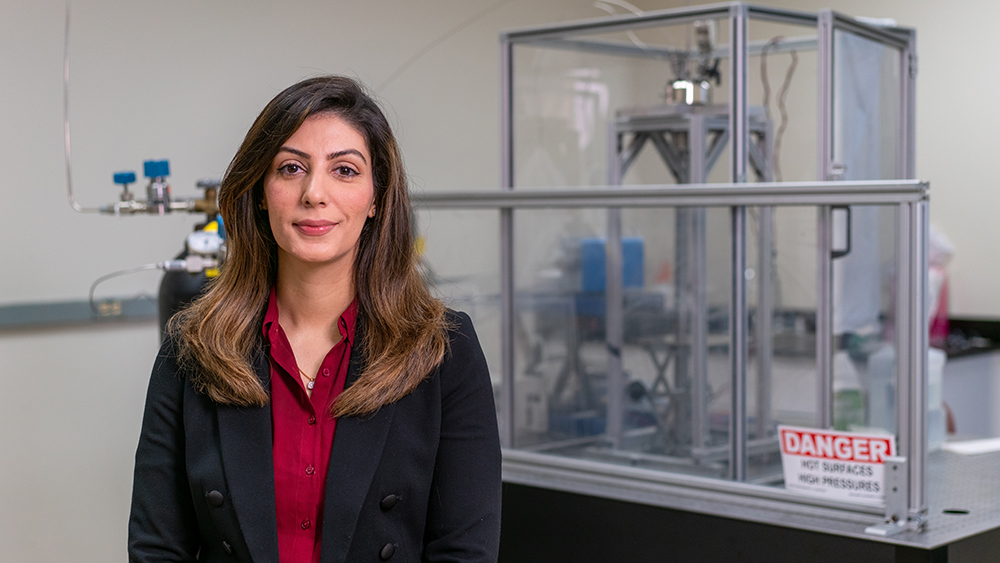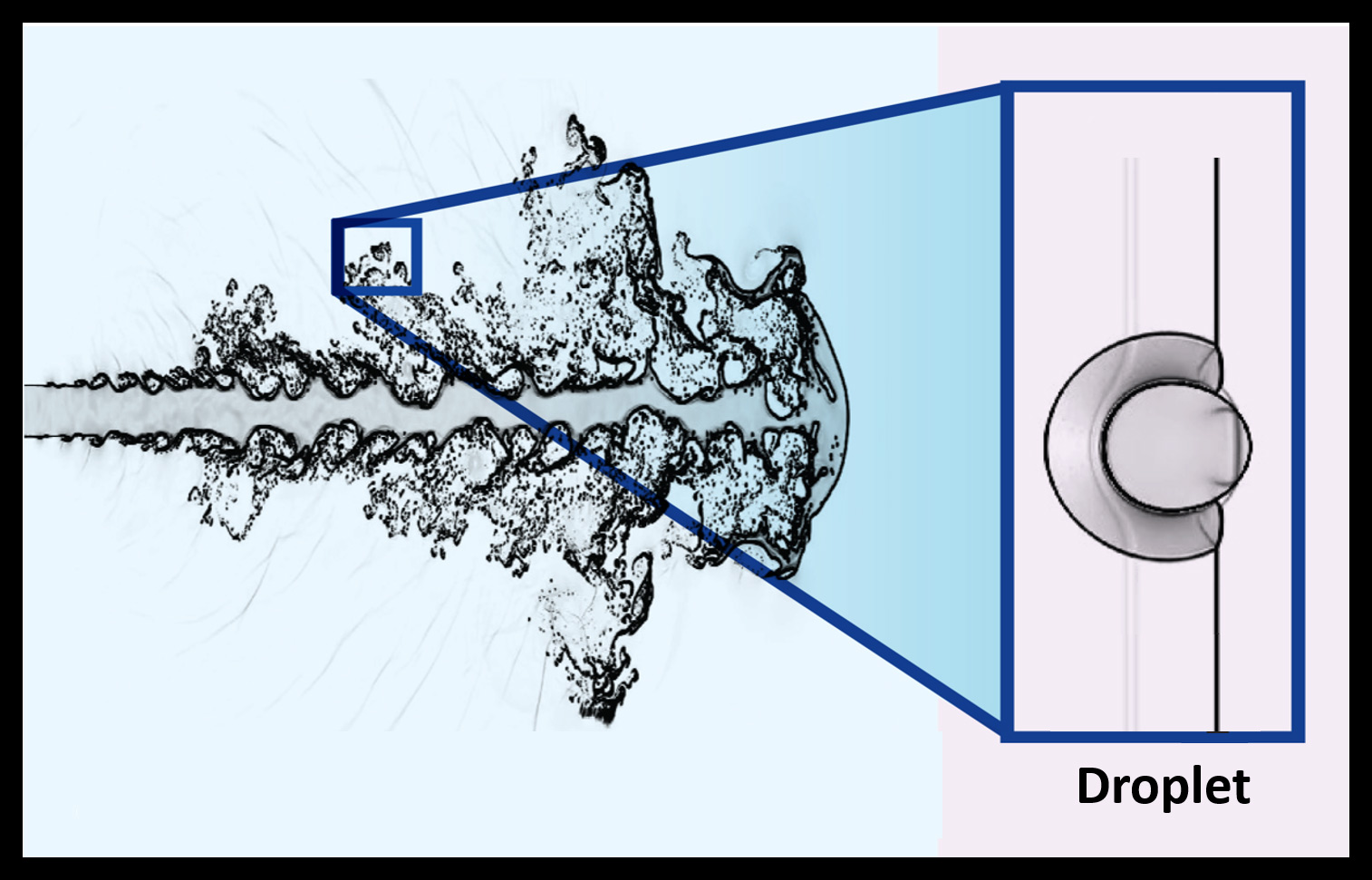
A new approach by Texas A&M University researchers to predicatively controlling supercritical liquid fuel injection mixing could significantly impact the performance and efficiency of engines powering vehicles from automobiles to hypersonic jets.
Dr. Dorrin Jarrahbashi and her students seek to shed light on the challenges in understanding the science of droplet breakup at supercritical conditions — pushing the fuel beyond the point where traditional liquid or gas phases apply. The research, which will use molecular dynamics and direct numerical simulations alongside high-speed experimental measurements, could help lead the way to a new generation of high-speed liquid-fueled propulsion systems that are faster and more efficient than the current standard.
Potential applications for the knowledge sought by this research include a broad range of high-pressure propulsion systems, including diesel, gasoline, biodiesel, dual-fuel engines, liquid rockets, scramjets, rotating detonation engines and gas turbines.
"This research will promote the next generation of high-speed liquid-fueled propulsion systems for supersonic and hypersonic air and space transportation and supercritical power generation cycles," said Jarrahbashi, assistant professor in the J. Mike Walker '66 Department of Mechanical Engineering. "These benefits will promote U.S. clean energy initiatives and strengthen national security, defense and economic competitiveness."
The National Science Foundation selected Jarrahbashi as a 2023 Faculty Early Career Development (CAREER) Award recipient. The award will further support her research into advancing liquid fuel combustion technology. The CAREER award honors promising junior faculty as they pursue cutting-edge research while simultaneously promoting excellence in education.
"I am very honored and pleased to receive this prestigious award, which provides the needed resources to build a firm foundation for a lifetime of leadership in integrating education and research in fluid dynamics with significant impacts on a wide range of applications to benefit society," Jarrahbashi said. "This CAREER project is significant as it generates new knowledge over multiple scales on breakup and phase change of supercritical droplets, difficult or impossible to gain experimentally or computationally. The new knowledge is critical for enhancing mixing to enable higher combustion efficiency and lower emission."

When liquid fuel injects into the compressed air of internal combustion engines, it breaks into several micron-size droplets — creating a fuel spray — before evaporating into an ignitable fuel-air mixture. This process is called atomization.
The details of this process determine the quality of the mixture and, in turn, the combustion efficiency and pollutant formation. To improve the performance, efficiency and environmental impact of these systems, modern engine design is moving toward higher-pressure systems that push fuel into supercritical conditions, dramatically changing the fuel's thermophysical properties.
Jarrahbashi's research will explore the mechanisms that apply to liquid fuels in droplet breakup at supercritical conditions — from molecular interactions to higher scales to advance supercritical combustion — to improve control of the mixing that occurs before combustion.
The research outcomes could fundamentally advance the field of multiphase flow. The research team's approach combines molecular dynamics with direct numerical simulations in exploring supercritical fluids, an area rich with potential but challenging to navigate. Jarrahbashi hopes her approach will provide her team and peers with a powerful new tool capable of making a significant impact in the fluid dynamics and combustion community.
"What excites me about this project is that it introduces the first coupled molecular dynamics-direct numerical simulations approach for modeling supercritical breakup to enable implementation of the molecular interfacial behavior in modeling high-speed multiphase flows," Jarrahbashi said.
One of this project's challenges is finding a way to measure droplet atomization in high-pressure and high-speed conditions. These situations can involve shockwave interaction with the fuel spray, entrapping the droplets in a cloud of vapor and requiring a knowledge of the phase change process and surface tension changes rooted in the molecular-level interaction at the droplet interface.
"Computational modeling of supercritical breakup requires knowledge of the phase change process and surface tension changes rooted in the molecular-level interaction at the droplet interface," Jarrahbashi said. "Due to lack of experimental data and limitations of theories on interfacial behavior, surface tension effects are overlooked in modeling supercritical flows. Molecular dynamics simulations emerge as a unique tool to determine the link between phase change and surface tension behavior in supercritical flows."
To combat this obstacle, the team will combine the methods of coupled molecular-continuum simulations and experiments using a novel computational approach focusing on the molecular level to the micro-scale.
However, molecular dynamics simulations are limited by the computational costs. Fortunately, there are resources available at Texas A&M to help in easing the limitations. Jarrahbashi and her team will be using the highly efficient parallel computational simulation resources of the Texas A&M High-Performance Computing Center to overcome these computational challenges posed by coupled molecular dynamics and direct numerical simulations.
The project will also include a collaboration with Sandia National Laboratory to conduct high-speed microscopic imaging of supercritical sprays and provide students an opportunity to work alongside its Combustion Research Facility as the team works to set up and validate its models.
The educational component of Jarrahbashi's CAREER award includes work aimed at cultivating an inclusive learning environment in fluid dynamics and diversifying future leaders in STEM by fostering sustained mentorship for underrepresented minorities and women. Components of the plan include training high school teachers and informing students and parents at school's science, technology, engineering and math events to enhance public literacy on fluid mixing to promote clean combustion.
"The vision motivating my education approach is that creating an inclusive and integrated education-research framework will cultivate a sense of relatedness and competence in students to pursue higher education and career in STEM and, in turn, decrease the attrition rate," Jarrahbashi said. "Executing this vision requires intervention in the early stages of education by preparing parents, teachers and students."